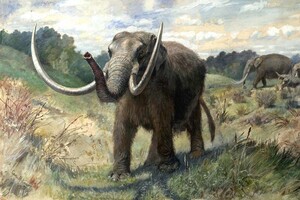She told about the ecosystem of the ancient forest in which animals lived.

Scientists have identified the DNA of microbes, plants and animals, whose age is estimated at two million years. This is the oldest known DNA, according to The Jerusalem Post. It was found in Greenland, near the mouth of a fjord.
Yes, the samples include the DNA of a variety of animals, including mastodons, reindeer, hares, lemmings and geese, as well as plants, including poplar, birch and thuja, and microorganisms , including bacteria and fungi.
Read also: Mammoths of America died out much later than thought
The found ecosystem has no analogues in the modern world. Scientists note that the discovery of mastodon DNA came as a surprise to them. It is a relative of elephants that lived in Central and North America until it died out about 10,000 years ago, like other Ice Age animals. The new finding shows that the habitat area of these animals was much wider than previously thought.
“The mastodon was a big surprise. It has never been found in Greenland before. However, the biggest surprise was this unique ecosystem of arctic and temperate species mixed together that has no modern counterparts. I don't think anyone could have predicted that Greenland would have such a diversity of plants and animals two million years ago, when the climate was very similar to what we expect to see in a few years due to global warming,” said Eske Willerslove, Director of the Center for Geogenetics of the Lundbeck Foundation and the head of the research.
Although DNA is “degradable”, new research shows that under the right conditions, such as permafrost, it can last much longer. Researchers believe they may be able to find four million-year-old DNA in the future.
Researchers extracted and sequenced DNA from 41 organic-rich sediment samples obtained from five sites on the Peary Land Peninsula jutting into the North The icy ocean. Microscopic fragments of DNA were extracted from the clay and quartz in the sediment. They belonged to more than 100 species of animals and plants.
The samples were collected back in 2006, but previous attempts to extract DNA from them were unsuccessful. Since then, analysis methods have improved, eventually leading to the breakthrough.
“We think this is because the DNA has bound itself to the mineral particles, allowing it to survive beyond , which was considered possible. This connection reduces the rate of spontaneous chemical decomposition,” said Willerslev.
The scientist emphasized that the discovered DNA fragments cannot be used to resurrect extinct species, but may reveal the secrets of how plants can become more resistant to of climate change.
The previous record holder was DNA extracted from a mammoth tooth, which was 1.2 million years old. It was also preserved in permafrost.
Related video
Previously, a gold miner discovered the mummified remains of a baby woolly mammoth in the Yukon Territory in Canada. The female mammoth was named Tr'ondek Khvech'in Nun cho ga, which translates from the local dialect as “big baby animal”.




